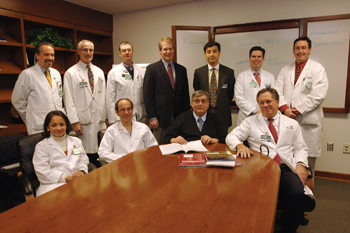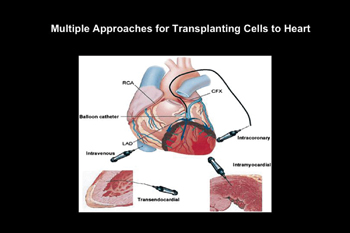
The bone marrow stem cell heart therapy team includes (front row from left) Pampee Young, M.D., Ph.D.; Jeff Rottman, M.D.; Antonis Hatzopoulos, Ph.D.; Douglas Vaughan, M.D.; (top row from left) Thomas Di Salvo, M.D.; Robert Piana, M.D.; Mark Lawson, M.D.; James Greelish, M.D.; David Zhao, M.D., Ph.D.; Jeff Dendy, M.D.; and James Muldowney, M.D.
photo by Anne Rayner
VUMC set to test novel heart therapy

Advanced treatment options, including the use of stem-cell based therapies, have proven to restore injured and/or lost cardiac tissue to improve heart function.
Vanderbilt University Medical Center is set to be the first in the region to use bone marrow stem cells to regenerate the heart muscle after heart attack in patients undergoing coronary artery bypass (CAB) procedures.
In early 2006, Vanderbilt will enroll patients in a randomized study to provide the novel, cell-based therapy to patients with cardiovascular disease.
The therapy represents a new direction in heart treatment, which historically has focused on improving blood flow to the heart.
“This is a whole new approach and opportunity to regenerate heart muscle in patients with severe heart dysfunction,” said Douglas Vaughan, M.D., chief of the Division of Cardiovascular Medicine. “This may develop into a new alternative to help the large numbers of patients with heart failure, given the practical and financial limits of heart transplantation.
“The idea that we can regenerate the heart using stem cells is one of the most exciting things to happen in the cardiovascular field. Studies using stem cell therapy have shown remarkable potential for improvement of heart function.”
The study, “Bone Marrow Stem Cell Therapy in Patients with Severe Ischemic Cardiomyopathy,” will enroll only those patients scheduled for CAB and with decreased ventricular function (inadequate pumping by the heart) and between ages 18-75. Sixty patients will be enrolled during 2006.
Half of the patients will receive transplantation of autologous bone marrow (a collection of their own stem cells) while the others will receive the standard therapy used in bypass procedures. Patients will receive a cardiac MRI at three-month intervals after surgery to determine if the heart function has improved.
A cardiac MRI shows very detailed images of the ventricular structure and function of the heart. Doctors will examine the wall of the heart for thickness and ability to contract as a measuring tool for success.
Most of the work with cell-based therapies for the heart is centered in Europe, said Vaughan, with a few centers in the United States exploring the treatment.
Vanderbilt's involvement in the pioneering treatment is threefold.
“This study will launch our initial efforts in regeneration therapy for the heart, strengthen our basic research and translational research on ventricular stem cells and heart muscle regeneration and use it as a springboard to enhance our competitive profile to become one of the centers in the cardiac regeneration network,” said Vaughan, the co-principal investigator with Antonis Hatzopoulos, Ph.D., associate professor of Medicine.
This fall the National Heart, Lung and Blood Institute (NHLBI) of National Institutes of Health (NIH) created a consortium of clinical centers to investigate the use of cell-based therapies in the treatment of cardiac disease. The cooperative, the Cardiovascular Cell Therapy Research Network, currently includes Johns Hopkins University, Baylor University Medical Center and the University of Pittsburgh Medical Center. Vanderbilt is seeking to be one of the five centers added to this elite group within the next year to study this novel approach.
Heart disease is the leading cause of death in the United States. Five million people suffer from heart failure with nearly 2 million deaths a year. The damage to the heart muscle from various cardiovascular diseases often leads to heart failure. Stem-cell therapy is one weapon cardiologists are hoping to use to fight the battle against heart-disease.
Hatzopoulos, a recruit from Munich, Germany, came to Vanderbilt earlier this year. He has more than 10 years experience working with endothelial progenitor cells.
“Current treatments aim to stabilize, synchronize and improve the beating of the remaining healthy heart muscle, but there are ways to recover the lost cardiac tissue,” said Hatzopoulos. “Regenerative medicine offers the hope to partially restore missing heart cells and replace scar tissue thus improving heart function and the patient's quality of life.”
Vanderbilt's approach includes a multidisciplinary team that will determine the safety of the new therapy, the efficacy of the procedure and the optimal delivery site of the cells.
While a patient is undergoing bypass surgery, the stem cell transplant team will harvest the bone marrow from the patient's hip. While the cells are being prepared, the surgeons will begin the bypass.
Once that is completed, the patient’s stem cells will be administered either down a catheter into the coronary artery where the cells will migrate into the tissue or injected directly into the myocardium or muscle of the heart.
“The bone marrow is enriched with endothelial progenitor cells (EPC),” said Vaughan. “It is thought that these cells can facilitate the growth of new blood vessels and augment the function of the heart.”
Vaughan, the C. Sidney Burwell Professor of Medicine and professor of Pharmacology, said the heart muscle regeneration therapy has several encouraging outcomes including its cost effectiveness and being better tolerated (no rejection issues).
“We have already begun getting phone calls from both physicians and patients alike inquiring if we have started using this therapy,” Vaughan said. “There is a lot of interest in the community centered around regeneration. It is debunking a longtime theory that injured heart muscle could not be repaired. This could be a lifeline for heart failure patients, whose lives are measured in years.”
Hatzopoulos' own lab has been studying pre-clinical disease models in mice, rabbits and pigs to show that the transplanted cells “stimulate the formation of new vessels that are necessary to restore blood supply to the injured organ.”
“To our surprise, we also found that the transplanted EPCs appear to act as biocatalysts rescuing dying cells, reducing inflammation and stimulating local repair and regeneration, he said.
Hatzopoulos is working on the molecular basis behind those beneficial effects with the hope of taking the information to create new ways to “prepare the patient's heart for cell transplantation or to engineer better stem cells for therapy.
“What is particularly rewarding to cardiologists and regenerative scientists is that cell therapy in the clinic has sprung directly from pre-clinical and clinical research within medical and biology departments around the world,” Hatzopoulos said.
Start-up funds for the study were provided by the Department of Medicine and the Vice-Chancellor's office. If accepted into the network Vanderbilt will receive $3.5 million to support the program over a five-year period.
Other members of the VUMC team include: Tom DiSalvo, M.D., medical director, Vanderbilt Heart Institute; Friedrich Schuening, M.D., Bone Marrow Transplantation; James Greelish, M.D., Cardiac Surgery; David Zhao, M.D., Ph.D., director, Cardiac Catheterization Laboratory; Pampee Young, M.D., Ph.D., assistant professor of Pathology, Frank Harrell Jr., Ph.D., chair of Biostatistics and Mark Lawson, M.D., Cardiac MRI.













